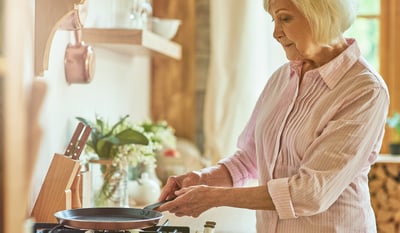We are closely monitoring the coronavirus (COVID-19). Read our statement here.

6 Ways to Improve Home Safety for Seniors
Schedule a Tour Home safety should be a concern at any age, but particularly for seniors. In fact, injuries from falls, home fires and medication errors are much more common among those 65 and older for reasons that may include weaker muscles, more brittle bones, slower reaction times, impaired vision and balance, or perhaps even diminished cognitive abilities. But there are ways to reduce your risk. Here’s how to improve home safety for seniors.
Home safety should be a concern at any age, but particularly for seniors. In fact, injuries from falls, home fires and medication errors are much more common among those 65 and older for reasons that may include weaker muscles, more brittle bones, slower reaction times, impaired vision and balance, or perhaps even diminished cognitive abilities. But there are ways to reduce your risk. Here’s how to improve home safety for seniors.
- Fall-proof your home: As much as possible, clear walking paths, add handrails to both sides of the stairs, have adequate lighting, remove or add non-slip mats under throw rugs, install grab bars and non-slip mats in the bathroom, and get a reach stick for items that are up high to avoid standing on step stools or ladders. Also make sure you have the appropriate mobility devices to move around your home safely.
- Practice fire safety: Make sure to stay in the kitchen when you’re cooking and avoid wearing loose-fitting clothes. Keep flammable items like dish towels, paper/plastic bags, and curtains at least three feet from your cooktop, and keep grills 10 feet away from the house, shrubs or bushes. If you need to use space heaters, keep them at least three feet from anything flammable and always turn them off when leaving the room. Also, have someone inspect your furnace and/or fireplace yearly, check smoke/carbon monoxide detectors monthly (which you should have on every floor and near every bedroom), and have easily accessible fire extinguishers. You might also consider installing a home fire sprinkler. Lastly, never leave a room with a candle burning in it, and don’t overload electrical outlets or extension cords.
- Carefully manage medications: We know how hard it can be to manage multiple prescriptions each day, which is why you need to be extra vigilant to avoid errors. Always follow your doctor’s instructions exactly and read the package insert. Also, make sure to take medications for the duration of prescription (even if you feel better), refill prescriptions early so you don’t run out, and use pill organizers or apps to keep track of your medications as well as dosage times.
- Be prepared for emergencies: In addition to 911, ensure you have poison control as well as your neighbors’ numbers handy. Also, identify at least two ways to exit your home in case of emergency. Consider getting a generator in case of a power outage to keep oxygen, CPAP, and other medically-necessary machines functioning. What’s more, a personal emergency response system (a wearable call button that contacts first responders and/or a friend or family member if you need emergency help) is a must.
- Beware of scams: We consider this a part of home safety, too, as many seniors fall victim to scams. To protect yourself, don’t be pressured into making a purchase, signing contracts or making donations until you’ve discussed it with a trusted friend or family member. Also, never share personal information (SSN, credit card, bank account or passwords), always ask for written details of offers or prizes, and wait to respond until you have reviewed them thoroughly.
- Drive safely: When living at home, driving is typically a necessity so it’s important to keep up with regular physicals as well as hearing and vision checkups to proactively manage any issue that could affect your driving. In addition, AARP and AAA offer safe driving refresher courses that can not only improve your safety and help you to better understand vehicle technology, but completion may also result in auto insurance discounts.
Home Safety for Seniors Made Easy
While these tips can certainly improve home safety for seniors, it can be a lot to manage. Not to mention the cost of safety upgrades such as grab bars and handrails, wheelchair ramps, or more substantial remodeling to widen doorways or adjust flooring.
On the other hand, senior living communities are designed specifically to include safety features such as emergency response systems, grab bars, ramps, generators, and transportation as standard. But these communities have plenty of other benefits that can also be harder to come by at home such as maintenance-free living, a full calendar of social and enrichment opportunities, and a host of resort-like amenities to not only make life more convenient but also to help you make the most out of it!
For more information, download our Stay or Go Guide to help you decide between care at home or in senior living or contact us today to schedule a tour.

